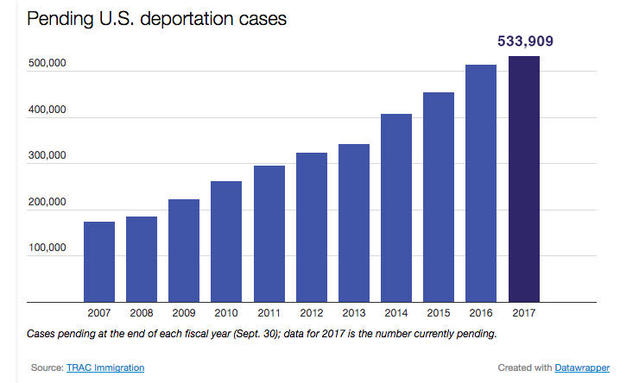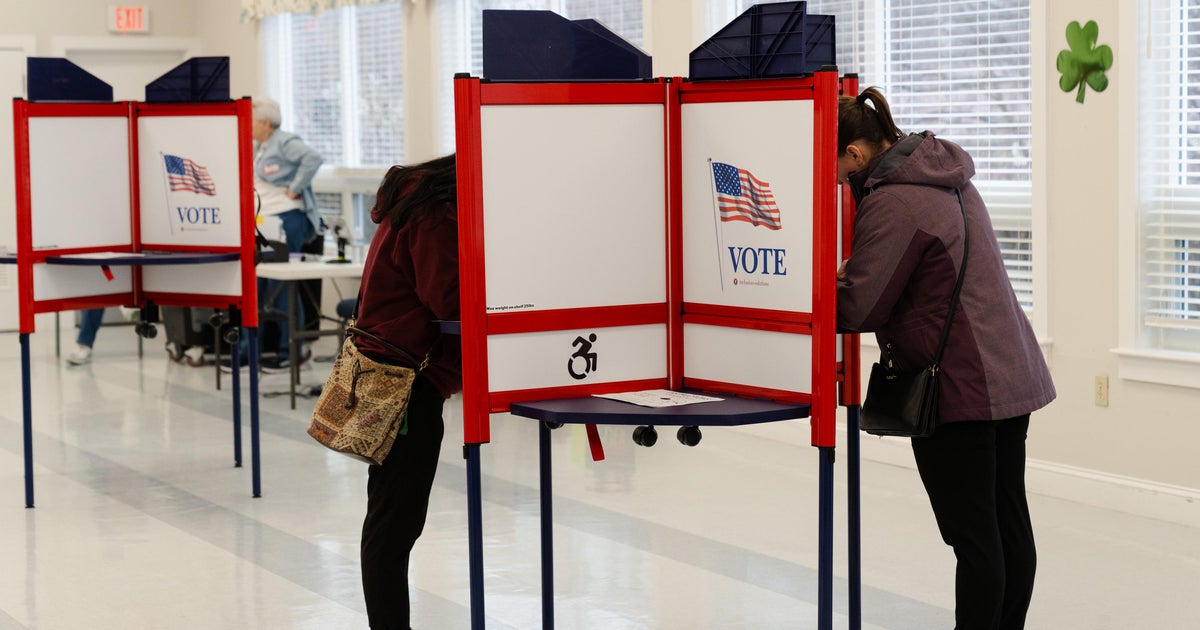Overloaded U.S. immigration courts a "recipe for disaster"
President Donald Trump is taking what he portrays as a hard-nosed approach to undocumented immigrants, issuing an order this week to boost the number of U.S. border patrol agents and to build detention centers.
But what happens when a federal push to ramp up arrests and deportations hits a severely backlogged federal court system?
“It’s a recipe for a due process disaster,” said Omar Jadwat, an attorney and director of the Immigrant Rights Project at the ACLU. Already, he pointed out, there are “large, large numbers of caseloads” in immigration court, and Mr. Trump’s directives threaten to greatly increase the number of people caught in the system, he said.
Just how backlogged is the system for adjudicating deportations and related legal matters? America’s immigration courts are now handling a record-breaking level of cases, with more than 533,000 cases currently pending, according to Syracuse University’s TRAC, a data gathering site that tracks the federal government’s enforcement activities. That figure is more than double the number when Mr. Obama took office in 2009.
As a result, immigrants awaiting their day in court face an average wait time of 678 days, or close to two years.
Immigrant rights advocates say the backlog is likely to worsen, citing Mr. Trump’s order on Wednesday to hire 5,000 additional border patrol agents while also enacting a freeze on government hiring. Whether the U.S. Justice Department, which oversees the immigration courts, will be able to add judges given the hiring freeze isn’t clear.
A spokeswoman from the DOJ’s Executive Office for Immigration Review said the agency is awaiting “further guidance” regarding the hiring freeze from the Office of Management and Budget and the Office of Personnel Management. In the meantime, she said, the agency “will continue, without pause, to protect the nation with the available resources it has today.”
Those resources aren’t deep. The Justice Department expects to have 302 sitting immigration judges as of Feb. 3, up from 237 in 2015. Given the large number of cases waiting to be heard relative to the available judges, the system can prove daunting on both sides of the bench. In a 2014 Washington Post profile of an immigration court judge, the justice was given an average of seven minutes per caseto arrive at a ruling.
“Based on the order from earlier this week and the hiring freeze, it speaks to this gross lack of understanding about how little we invest in the courts, which is part of the enforcement process,” said Avideh Moussavian, policy attorney at the National Immigration Law Center. “If you really believe in the core values of justice and the integrity of our laws, you don’t try to deport someone before they have a meaningful day in court.”
On top of the stress of waiting months for a hearing and then receiving only minutes before a judge, immigrants aren’t provided legal counsel. Finding an attorney falls on individuals, which can prove challenging on a number of fronts, from language barriers to cost.
As a result, many immigrants arrive in court without legal representation. About 60 percent of detained immigrants lack counsel by the time their cases were completed, while more than one-quarter of nonretained immigrants failed to secure legal representation, according to the 2011 New York Immigrant Representation Study.
Yet research demonstrates that hiring an attorney can vastly improve outcomes for those facing deportation or requesting asylum. The study found that three-quarters of immigrants who had attorneys and were never detained had successful outcomes. By comparison, only about one in 10 immigrants who lacked legal representation and weren’t detained had successful outcomes.
Costs can mount quickly. A typical bond in New York immigration courts costs $10,000, almost twice the national average, the 2011 study found. Hiring an attorney isn’t cheap, either, even for those who are able to secure the help of a nonprofit removal-defense provider, whose costs are lower than private attorneys. The study found that non-profit representation costs for deportation cases can add up to as much as $1,000, a financial hardship for low-income immigrants.
“There are deep due process problems with expecting people to represent themselves,” the ACLU’s Jadwat said. “First of all, the actual law itself, even within lawyers, is famously complex. There are language issues. It’s more of the situation where you would think fairness would demand you would give people lawyers.”
The increase in border agent hiring and stepped up enforcement will likely cost the taxpayers plenty, as well. In addition to the wall that Mr. Trump has ordered to be built on the border between Mexico and the U.S., his order demands that the Department of Homeland Security “immediately construct” or contract out new detention centers for immigrants caught near the Mexican border.
Taxpayers could face billions in additional costs for new detention centers and border agents. The Homeland Security agency’s budget calls for $2.2 billion to pay for 31,000 detention center beds, which Politico reported could ramp up to annual costs of $10 billion, thanks to Mr. Trump’s orders. The additional border agents may require an extra $900 million in spending, it estimated.
Notably, Mr. Trump’s plan to ramp up immigration enforcement comes at a time when fewer unauthorized immigrants are in the labor force than in 2008, according to the Pew Research Center’s analysis of Census Bureau data.
Mexicans, who have drawn the brunt of Mr. Trump’s criticisms, represent a shrinking number of unauthorized immigrants, declining from almost 7 million in 2007 to 5.9 million in 2014, Pew’s analysis found. On the other hand, illegal immigration from Asia has been climbing in recent years.
Despite Mr. Trump’s campaign promise to build a wall, Americans largely aren’t in favor of its construction, with Pew finding that only 39 percent viewed it as a “very” or “somewhat” important goal. By comparison, 72 percent of Americans say they want the government to allow people who arrived in the country illegally as children to remain able to stay, while almost two-thirds want to see most unauthorized immigrants be able to stay here legally, Pew found.
“Immigrants, regardless of their status, overwhelmingly pay taxes and contribute to Social Security,” Moussavian said. “They are on the whole givers and investors in our community and in our economy, despite often receiving little in return.”
Despite Mr. Trump’s rhetoric that Mexican immigrants “have lots of problems” including criminal inclinations, research has shown that immigrants overall are less likely to commit crimes than native born Americans. Deporting or detaining millions of unauthorized immigrants also could hurt the U.S. economy, with economists estimating that undocumented workers contribute about $5 trillion in gross domestic product over a decade.
“We’ve recently made strides -- that are bipartisan -- of moving away from mandatory sentencing and that realizing our country has suffered greatly economically by virtue of over-reliance on incarceration, and it hasn’t resulted in positive results,” Moussavian said. “Those lessons are being ignored in immigration.”





